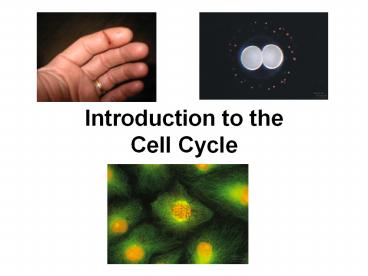Introduction to the Cell Cycle - PowerPoint PPT Presentation
Title:
Introduction to the Cell Cycle
Description:
Title: Introduction to the Cell Cycle Author: Athena Kraus Last modified by: WCCUS Created Date: 11/9/2006 3:03:24 AM Document presentation format – PowerPoint PPT presentation
Number of Views:183
Avg rating:3.0/5.0
Title: Introduction to the Cell Cycle
1
Introduction to the Cell Cycle
2
Continuity of Life
- Life continues due to
- cell division production of cells
- This division process occurs as part of the cell
cycle, the life of a cell from its origin in the
division of a parent cell until its own division
into two.
3
Cell Division Functions
- Reproduction The division of a unicellular
organism reproduces an entire organism. - Growth Allows organisms to develop from a single
cell. - Repair Replaces and renews cells that die from
normal wear and tear and accidents.
4
Cell Division Overview
- Purpose
- the distribution of identical genetic material -
DNA - to two daughter cells - DNA is passed along, without dilution, from one
generation to the next - How?
- A dividing cell duplicates its DNA, allocates the
two copies to opposite ends of the cell, and then
splits into two daughter cells.
5
(No Transcript)
6
Genome
- Genome A cells entire genetic
- information, packaged as DNA
- Eukaryotes consists of several DNA molecules
- Prokaryotes often a single long DNA molecule
- A human cell must duplicate about 3 m of DNA and
separate the two copies such that each daughter
cell ends up with a complete genome.
7
Chromosomes
- DNA molecules are packaged into chromosomes.
- Every eukaryotic species has a characteristic
number of chromosomes in the nucleus. - Humans
- somatic cells (body cells) 46 chromosomes
- gametes (sperm or eggs) 23 chromosomes
- Each eukaryotic chromosome consists of a long,
linear DNA molecule. - Each chromosome has hundreds or thousands of
genes, the units that specify an organisms
inherited traits.
8
(No Transcript)
9
Chromatin
- DNA-protein complex
- Proteins help maintain the DNA structure and help
control gene activity - Organized into a long thin fiber
- After the DNA duplication, chromatin condenses,
coiling and folding to make a smaller package
the chromosome!
10
Putting it all together
11
Sister Chromatids
- Each duplicated chromosome consists of two sister
chromatids which contain identical copies of the
chromosomes DNA.
12
Overview
- The mitotic (M) phase of the cell cycle
alternates with the much longer interphase. - The M phase includes mitosis and cytokinesis.
- Interphase accounts for 90 of the cell cycle.






























